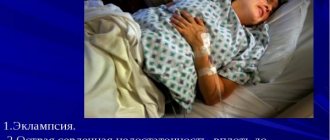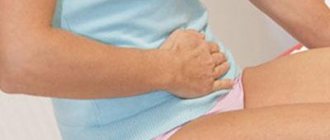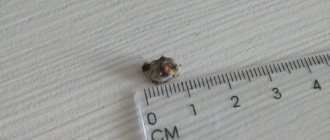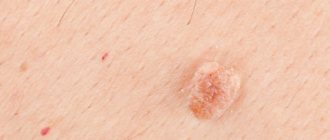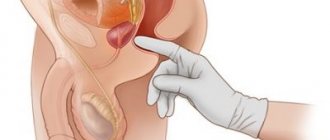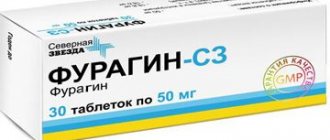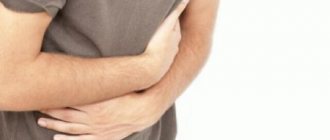By the age of three, the baby’s daytime and nighttime urination patterns should be fully formed.
If he periodically experiences involuntary urination, regardless of the degree of filling of the bladder, before falling asleep or during sleep, while awake, this is a reason to visit a doctor.
Such symptoms in children may indicate a serious illness - neurogenic bladder dysfunction in children, the treatment of which is a rather labor-intensive process. With this pathology, the reservoir and evacuation function of the organ is disrupted, which can cause the development of cystitis, chronic renal failure, hydronephrosis, and pyelonephritis.
A neurogenic bladder causes many problems for a child, since, in addition to physical suffering, it causes psychological discomfort and interferes with normal adaptation in a social environment, especially among peers.
Causes
With a pathology such as neurogenic bladder dysfunction in children, the causes of its occurrence most often have a neurological nature.
The following causes of neurogenic bladder in children are distinguished:
- organic damage to the central nervous system;
- birth defects;
- development of tumor and inflammatory processes in the spine;
- birth injuries and spina bifida.
The cause of the disease may be a functional weakness of the urination reflex.
These changes are associated with hypothalamic-pituitary insufficiency, late maturation of voiding centers, and disturbances in the activity of the autonomic nervous system. The development of the disease depends on the nature, level and degree of damage to the nervous system.
Girls are more susceptible to the disease. They owe this to the hormone estrogen, which significantly increases the sensitivity of detrusor receptors.
Complications of a neurogenic bladder
- Vesicoureteral reflux (VUR) - most often occurs with a hypoactive form of neurogenic dysfunction, when urine stagnates in the bladder, pressure is created, fluid is thrown back into the ureters, and then into the kidneys. This complication threatens the development of infection of the upper urinary tract (kidneys) - pyelonephritis.
- Hydronephrosis (accumulation of fluid in the renal pelvis) - develops with a severe form of hypoactive bladder. Excess fluid stagnates in the urinary tract, including the kidneys, which leads to their expansion and impaired excretory function.
- Peritonitis is an extremely rare complication of an underactive bladder. The bladder ruptures, urine enters the abdominal cavity and the development of an inflammatory process of the peritoneum.
- Arterial hypertension is an increase in blood pressure, which is a complication of severe NMP (Ochoa or Hinman syndrome).
Classification
The disease is classified according to various criteria. Based on the reflex changes of the organ, they are distinguished:
- hyperreflex , in which the spastic state of the detrusor occurs during the phase of urine accumulation. Hyperreflex disorder is most often associated with damage to nerve endings in the human brain. This type of disorder is characterized by the inability to hold urination. Urine does not have time to accumulate in the organ; when it is slightly full, there is a urge to empty it;
- normoreflex;
- hyporeflex , characterized by detrusor hypotension during fluid secretion. This condition is caused by disruption of the nervous system of the sacrum. The muscles of the organ are weakened and it cannot empty itself. Its walls gradually stretch, and it increases in size. This disorder is not painful, but it causes the sphincter muscles to relax, causing incontinence. Urine rising through the ureters into the pelvis causes foci of inflammatory processes in them.
According to the degree of adaptability of the organ to filling with urine, the disease is divided into:
- adapted;
- unadapted.
Organ dysfunction occurs:
- in a mild form . Frequent daytime urination, enuresis, and urinary incontinence caused by a stressful situation are typical;
- in moderate form . Lazy bladder and unstable bladder syndrome occurs;
- in severe form. Serious disturbances in the functioning of the organ appear: detrusor-sphincter disorder, urofacial syndrome.
An overactive bladder can cause severe cystitis, in which the organ shrinks.
What is a neurogenic bladder
This concept combines pathologies of the nervous regulation of the bladder (nerve centers, pathways), as a result of which the voluntary reflex accumulation of urine in the organ and its emptying are disrupted.
Nervous regulation is the effect of the nervous system on tissues and organs, ensuring the consistency of their activities.
The pathology itself is not life-threatening, but its symptoms significantly disrupt the child’s adaptation to the community. Depending on the type of lesion, the baby may experience both urinary incontinence and, conversely, pathological retention. As a result, the child begins to limit his communication with peers, lags behind in his studies, and has conflicts in the family.
This is interesting! The normal process of urination is divided into a storage phase and an elimination phase. During the storage phase, urine accumulates in the bladder to a certain level. In this case, the detrusor (bladder muscle) is relaxed, and the sphincter (muscle ring at the outlet of the bladder) is contracted. During the excretory phase, when urine has accumulated to a certain volume, the detrusor muscle contracts and the sphincter relaxes, urination occurs.
The act of urination normally occurs after a signal is received from the nervous system to the muscles. The detrusor muscle contracts, the bladder sphincter relaxes, and urination occurs.
Symptoms
The neurogenic bladder in children causes symptoms such as various urinary disorders, the severity and frequency of manifestations of which depend on the level of damage to the nervous system.
Symptoms of hyperactivity that predominate in children are frequent small urination, urinary incontinence and enuresis.
An older child often visits the toilet at night, and experiences discomfort when emptying the organ. The hypoactive form of the disorder is characterized by a lack of desire to empty the organ, and after urination there is no feeling of release from fluid.
Pain often occurs in the urinary canal, and inflammatory processes in the bladder cause cystitis. Also, when urine accumulates due to the low activity of the organ, stones form in it.
Urinary incontinence in girls during puberty occurs during heavy physical activity and manifests itself in the emission of small portions of urine. With a lazy bladder, urination occurs rarely, alternating with fluid incontinence, and is also accompanied by constipation and infections.
Neurogenic hypotension of the organ leads to impaired blood flow in the kidneys, scarring of the renal parenchyma and wrinkling of the kidney, nephrosclerosis.
Prevention
Since the condition of children suffering from urinary disorders significantly depends on the level of stress, the main preventive measure is monitoring the situation in the family and school (kindergarten), maintaining contact with the child and timely working through emerging conflicts. Parents should be wary if the child withdraws into himself, refuses to go to school, kindergarten or clubs, and looks tired. You need to carefully find out the cause of this condition and try to solve the problem, if necessary, with the participation of a psychologist. You should also undergo all routine examinations with a pediatric urologist and surgeon.
Urinary dysfunction in children is a delicate disease, and it needs to be solved together with a competent specialist. Use the search on our portal or entrust the choice to us. The doctor selection service is free. Call the help desk and we will recommend a specialist who will deal with your problem and will meet at a convenient address.
Diagnostics
The initial diagnosis of the disease includes collecting an anamnesis of the disease. The doctor collects information about the presence of similar diseases in the family, about injuries and pathologies of the nervous system.
Kidney ultrasound
Further clarification of the causes of the disease involves a comprehensive examination with mandatory consultation with a pediatrician, urologist, nephrologist, pediatric neurologist and psychologist.
To identify possible kidney disorders in children, a biochemical blood test, Zimnitsky test, Nechiporenko urine test and bacteriological examination of urine are prescribed.
For a neurogenic bladder, a urologist prescribes to a child:
- Ultrasound of the kidneys and bladder, which determines the level of residual urine;
- voiding cystography;
- survey and excretory urography;
- computed tomography and MRI of the kidneys;
- endoscopic examination;
- scintigraphy.
An important point in diagnosis is the collection of data on the amount of fluid drunk and urine excreted.
To confirm or exclude pathology from the central nervous system, the child is prescribed an EEG and Echo-EG, as well as X-rays and brain examination.
Diagnosis of OAB in children
In order to clarify the cause of the symptoms listed above, the doctor will prescribe several tests.
Here are some of them:
- Urine test for infection . This is a bacteriological culture of urine, which will help identify bacteria causing the infection if they are found there and select an effective antibiotic.
- Nechiporenko test . Test for detecting urine volume.
- Blood analysis . It is prescribed to exclude diabetes and check the general condition of the baby.
- Ultrasound , if necessary, CT examination or MRI.
- Biochemical and general examination of urine.
Frequent urination or wetting before the age of three should not be a concern for adults.
Treatment
For a disease such as neurogenic bladder in children, treatment depends on the severity of the disease and the occurrence of concomitant ailments.
It consists of drug and non-drug therapy, and if necessary, surgical intervention is included.
The success of treatment depends on adherence to a daily routine, including daytime naps and walks. It is important to protect the child from traumatic situations. The doctor may prescribe a course of physical therapy for the child.
Physiotherapy includes electrophoresis, magnetic therapy, and electrical stimulation of the organ. In case of hypotension, the child is forced to sit on the potty every three hours, or a catheter is installed.
Children with hypotension of the urinary bladder are prescribed:
- uroseptic drugs in small doses;
- nitrofurans;
- nitroxoline;
- immunotherapy;
- herbal preparations.
Endoscopic surgery includes:
- resection of the bladder neck;
- implantation of collagen at the mouth of the ureter.
According to indications, the volume of the organ is increased using cystoplasty. Psychotherapeutic methods will help identify the psychological cause of the disease.
Homeopathic remedies can only help with mild forms of disorders.
The People's Pharmacy recommends brewing lingonberry leaves, which have a diuretic and antiseptic effect.
This property of the plant is used when the activity of the organ is low.
Enuresis is treated with sage and rosehip decoction. It is useful for children to drink carrot juice when they are ill.
Treatment of overactive bladder in children with folk remedies
The unifying syndrome of urinary disorders called “Neurogenic Bladder” is a fairly common phenomenon, although most people are embarrassed to consult a doctor with such a delicate problem.
This is a disruption in the interaction between the nervous system and the muscles of the bladder. Excessive activity of the bladder muscles is fraught with the occurrence of spontaneous uncontrollable and frequent urges. At the same time, decreased tone of other muscles does not allow the bladder to fully contract. First, this leads to incomplete emptying and excessive emptying - the accumulation of urine, which begins to ooze drop by drop. And then a secondary infection in the urinary system and other complications occur, accompanied by pain in the lower abdomen.
Neurogenic dysfunction is often hidden and, accordingly, in this case it is unsuccessfully treated under the guise of other common diseases such as cystitis (inflammation of the bladder mucosa). Long-term and ineffective treatment ultimately leads to a search for hidden problems, for example in the nervous system. But time may already be lost, and the task of combating pathology becomes more complicated.
Diagnosis is carried out by a urologist together with a neurologist, using laboratory and instrumental methods. During the examination, the urologist excludes diseases simulating neurogenic failure using cystoscopy. This painless procedure allows you to view the inside of your bladder through a fiberoptic tube. Urine and blood tests and other laboratory tests can detect the presence of infections. Then the contractile functions of the bladder are determined. After all, before starting treatment, you need to understand the cause of the disease and its form.
Indeed, the difficulty of diagnosing and treating this disease lies in the need for a multidisciplinary approach - a urologist and a neurologist must work together, each in their own direction, interacting and coordinating the treatment process. It should be taken into account that a considerable number of patients who consult a urologist suffer from a neurogenic bladder disorder. This means that the syndrome is based on a pathology of the nervous system, and disruption of the urinary system is the result of a neurological disease.
Failures in any part of the nervous system, be it the brain or spinal cord, nerve roots and endings, can result in problems with urination. Therefore, doctors, having completely ruled out a urological problem, conduct a neurological examination, which, if necessary, includes: electroencephalography (EEG), computer and magnetic resonance imaging of the brain (MRI). But the most modern method, which has no alternative in terms of accuracy in diagnosing diseases of the peripheral nervous system, is electroneuromyography . The study allows us to determine the degree of damage to nerve fibers and the prognosis for their recovery.
With increased activity of the bladder muscles, drug therapy for neurogenic dysfunction consists of using drugs that have a relaxing effect on the urinary tract. These are adrenergic blockers (oxybutynin), anticholinergics (trospium chloride, spasmex, novitropan) and others. They relieve spasms and reduce the tone of the smooth muscles of the bladder. For example, Spazmex is prescribed at a dosage of 45-60 mg per day in 2-3 doses. The average duration of treatment is 2-3 months.
The effectiveness of modern medications to reduce bladder muscle activity is limited by many contraindications and side effects. Self-medication with them is strictly unacceptable. Only a doctor can prescribe these drugs.
One of the latest medical advances in the treatment of a neurogenic bladder is injections of botulinum toxin into its wall (Botox, Lantox), which help relieve unpleasant symptoms associated with increased tone. They also relax the smooth muscles of the bladder. Injections are carried out after a thorough outpatient examination and clarification of the type of urination disorders. The duration of stay in the clinic is 1-2 hours, the procedure can be performed in your sleep and is completely painless. The injection is performed once, and the effect lasts for 6-12 months, depending on the individual characteristics of the patient. ,
If you contact specialists late, treatment of the disease is complicated and can lead to the development of chronic cystitis, reflux (reflux of urine from the bladder back into the ureters and kidneys, followed by their atrophy and the development of chronic renal failure).
If urination problems occur, you should immediately contact a urologist.
With reduced activity, the disease is more difficult to treat, since there is a high risk of developing secondary infectious inflammation when stagnant urine returns to the ureters and kidneys. To ensure outflow with a “lazy” neurogenic bladder and urinary retention, it is sometimes necessary to periodically change catheters. Physiotherapy is also used. And only when it is not possible to cure the neurogenic bladder with conservative therapy, they resort to surgical intervention.
In case of neurogenic bladder disorder, restoration of lost functions is also possible with the help of autogenic training, psychotherapy sessions, and physical activity. Treatment includes mandatory exercises for the bladder and pelvic floor muscles. Regularly performing Kegel exercises helps to cope with many dysfunctions of the urinary system.
Slow compression . Tighten the muscles of the perineum as if you are stopping urination. Relax.
Abbreviations . Quickly tense and relax your pelvic muscles.
Ejections . Tighten your muscles as if you are ready to expel urine. Relax.
Elevator . First, tighten your pelvic muscles slightly, count to three, and relax. Then tense your muscles with greater intensity, count to three, and relax. Finally, tense your muscles as hard as you can, count to three, and relax.
These exercises must be performed at least 5 times a day, increasing the number of repetitions by 5 weekly until there are 30. Increase the number of exercises to 150 per day. Breathing during training is even.
Of course, folk methods and herbal medicine contribute to healing. Their advantage lies in the insignificance of side effects and the possibility of use without a doctor’s prescription.
For an overactive neurogenic bladder, an infusion of St. John's wort , which has earned good fame since the end of the 17th century, is useful.
20 g of dried herb St. John's wort, pour 1 liter of boiling water, leave for 1 hour. Take during the day instead of tea. The course of treatment is up to three months.
In a similar way, you can prepare and drink centaury infusion or St. John's wort with centaury in equal
The psycho-emotional background of the patient plays an important role in the treatment of the disease. Therefore, we recommend avoiding traumatic situations, following a daily routine, walking in the fresh air, and sleeping for at least 8 hours every day. In other words, maintain a healthy lifestyle.
And we must separately say about proper and balanced nutrition, without which treatment will not be effective. Eliminate irritating foods from your diet: citrus fruits, pineapples, chocolate, coffee, tomatoes, alcohol, sharp cheeses and seasonings. And instead of energy drinks and carbonated drinks, I advise you to quench your thirst with cranberry juice or herbal teas.
As you can see, the “disobedience syndrome,” despite its complexity, can be treated.
The suffering of these patients is much more varied and deeper. This includes not only “neurological” patients after severe injuries to the spinal cord and brain, road accidents, as a result of military operations, but also a large group of our readers. With age, people experience increasing weakness and atrophy of skeletal muscles (pelvic floor and abdominal muscles), muscles of hollow organs (bladder, urinary and rectal, gastric sphincters, bronchial tree) and other parts.
That is why in their medical practice, doctors advise walking at a brisk pace for 30 minutes twice a day. In 3-5 months the disease goes away. In people who are physically developed and engaged in active work, neurogenic bladder syndrome is less common. Although there is confidence that walking at a brisk pace will benefit everyone.
In addition, doctors strongly recommend abstaining from irritating foods, excessive consumption of beer and artificial carbonated and other drinks. Much healthier and tastier are natural compotes, decoctions of rose hips, lingonberries, viburnum, sea buckthorn, cranberries, and rowan berries. It is a source of natural vitamins and medicinal substances, which has a diverse positive effect on all organs and systems.
Take 100-150 g of crushed flowers of calendula, black elderberry and hawthorn, plantain leaf, lingonberry, string grass, knotweed, mix.
1.5 tbsp. spoons of the mixture pour 400 ml of cold water, heat to a boil and simmer for 5-7 minutes. Leave for an hour. Add 1 tbsp to the strained broth. a spoonful of honey (if there are no contraindications) and 1 tbsp. a spoonful of one of the juices: rose hips, viburnum, rowan. In some cases, I recommend 1 teaspoon of a pharmaceutical tincture of your choice: calendula, motherwort or valerian. In the presence of chronic inflammation of the bladder, appendages or prostate, an additional 40-50 drops of the pharmaceutical drug Citrosept. The duration of treatment with one collection is 2.5-3 months.
Take: birch leaf, sage, nettle, plantain, coltsfoot, marshmallow root, wheatgrass, horsetail grass, dill seeds - 50 g each and 200 g of rose hips. Grind everything and use it in the same way as in the previous recipe.
Prepare a collection of: mint, motherwort, columbine, currant leaf, linden, celandine, lingonberry, oak, plantain, horsetail grass, lemon balm, linden flowers, hawthorn, calendula, dill, fennel, coriander - 150 g each. Mixed and medicinal plants stored for future use can be used for short courses of treatment.
2 tbsp. Boil spoons of the mixture for 10 minutes in 500 ml of water, leave, strain and drink warm with honey before meals in 3-4 doses. The course of treatment is 10-15 days.
When the main diagnosis is combined with urolithiasis, it is recommended to make a composition of equal proportions of knotweed, string, St. John's wort, agrimony, immortelle, hop cones, rosehip and wheatgrass roots, wild carrot seeds and dill.
The crushed raw materials are brewed at the rate of 1 tbsp. spoon per 500 ml of water and after 10 minutes of simmering over low heat, place in a thermos. Take warm with honey 20-30 minutes before meals or an hour after meals 3-4 times a day.
The herbs should last for 2 months. After two courses of herbal medicine, do an ultrasound. Usually, 3-4 courses of treatment are prescribed so that the patient recovers and the problem does not return.
If you have been diagnosed with Neurogenic Bladder, do not panic, be patient, and begin treatment. A urologist and a neurologist are the best assistants to solve this problem. Be healthy!
source
Author: nmed · Published February 28, 2020 · Updated May 25, 2019
Overactive bladder (OAB) is a disease associated with dysfunction of the bladder. In this case, a person experiences a frequent, strong urge to urinate that is difficult to control. In some cases, such patients experience urinary incontinence.
This disease occurs due to a violation of the innervation of the detrusor - the muscular layer of the bladder . Such a disorder is associated with neurological diseases or is idiopathic in nature - that is, it is not always possible to accurately determine the causes of the pathology. In any case, OAB can cause a lot of inconvenience to a person.
It is better to use non-drug methods to treat the disease.
- Bladder training and exercises to strengthen the pelvic floor muscles are effective.
- Improve the patient’s condition and take traditional medicines for the treatment of bladder diseases. This therapy will help restore normal functioning of the organ.
At the same time, folk remedies do not have a negative toxic effect on the human body.
The pathology is quite common. The disease occurs in men and women of different age groups. Overactive bladder in women often develops at a young age, and in men - in old age.
The disease also often occurs in childhood, as the child has less control over his bladder. It is worth noting that an overactive bladder in women often causes urinary incontinence, while in men this symptom develops less frequently.
Currently, it is not always possible to accurately determine the causes of bladder overactivity. It has been established that a strong, sudden urge to urinate is associated with increased activity of the detrusor, the muscular lining of the organ. Patients with an overactive bladder experience sudden muscle contractions of the bladder that the person is unable to control.
- neurological form of the disease - detrusor contractions are caused by neurological disorders;
- idiopathic form of the disease - the causes of bladder overactivity have not been precisely established.
- Impaired functioning of the central and peripheral nervous system: trauma, vascular diseases, degenerative and demyelinating processes.
- Thickening of the bladder walls due to prostate adenoma or urethral stricture. In this case, the detrusor tissues receive insufficient oxygen. Oxygen starvation leads to the death of neurons innervating the bladder and the development of spontaneous contractions.
- Anatomical disorders of the urinary tract. The abnormal structure of organs can lead to disruption of innervation and the development of OAB.
- An overactive bladder can occur as a result of age-related changes . Gradually, connective tissue grows and the blood supply to the detrusor deteriorates.
- Sensory impairments. This disorder develops in response to a complex of factors. In particular, thinning of the mucous membrane of the bladder leads to impaired sensitivity of nerve fibers. As a result, acids dissolved in urine act on unprotected nerve endings, causing involuntary spasm. Thinning of the mucous membrane often develops against the background of a decrease in the amount of estrogens in women after menopause.
An overactive bladder is manifested by the following symptoms:
- strong and sudden urge to urinate;
- urinary incontinence, the inability to control the urge;
- the bladder does not have time to fill completely, so the volume of urine is insignificant;
- more frequent emptying of the bladder (more than 8 times a day);
- night urge to urinate.
Such a disease is not dangerous, but can cause a lot of discomfort to a person and become an obstacle to the normal socialization of a child or the social life of an adult.
Urinary disorder can be caused by a complex of different reasons:
- infectious processes in the organs of the genitourinary system;
- kidney or bladder stones;
- bladder tumor and others.
Before making a diagnosis of “overactive bladder,” it is necessary to exclude all other possible pathologies of the urinary system. Therefore, a comprehensive examination of the body is carried out.
To make a diagnosis, the following tests are performed:
- ultrasound examination of the abdominal organs;
- laboratory tests of blood and urine;
- bacterial culture of urine;
- cytoscopy;
- urodynamic study.
The patient also needs to keep a urination diary for three days, where the exact volume of liquid drunk, the time of emptying the bladder and the amount of urine must be recorded.
For effective therapy, it is necessary to determine exactly why the patient has developed an overactive bladder.
- Treatment of the neurogenic form of the disease is aimed primarily at restoring the innervation of the organ and other functions of the nervous system.
- In the case of age-related changes or the idiopathic form of the disease, therapy is aimed at improving blood circulation in the bladder and strengthening the detrusor.
Non-drug treatment of OAB is used. This therapy includes the following areas:
- bladder training;
- behavioral therapy;
- exercises to strengthen the pelvic muscles;
- correction of nutrition and drinking regime.
- The amount of urine directly depends on the amount of fluid consumed. This amount includes not only drinking, but also liquid contained in food: soups, fresh vegetables and fruits. The patient is advised to reduce the amount of fluid consumed and give preference to clean water . Many drinks, especially green tea and coffee, have a diuretic effect and increase the frequency of detrusor contractions and the urge to urinate.
- It is necessary to correct the nutrition of such a patient. Eating too much protein puts a strain on the kidneys and leads to increased urine production. Such patients are advised to increase the amount of fiber in their diet . Plant fiber promotes good digestion and prevents constipation. It has been shown that overactive bladder is more likely to occur in the setting of constipation, since in this condition there is external pressure on the bladder from the intestines.
- People with OAB often have the urge to urinate at night. To improve the situation and normalize night sleep, you need to stop drinking at least three hours before going to bed. Patients should also completely stop drinking alcohol, as it has a diuretic effect.
- The patient needs to make a schedule for visiting the toilet and strictly adhere to it. Even if by a certain time a person does not feel the urge to urinate, he still needs to visit the toilet. The intervals between visits to the toilet should be small at first, but gradually they need to be increased. This schedule will help you control your bladder better.
- The disease also needs to be taken into account when planning your daily route. It is important that the patient has constant access to the toilet, since it is very difficult for such people to predict and control the urge to urinate.
- Urinary incontinence can be a big problem for patients with this disease. To improve the situation, you can use special adult diapers. This measure will hide the deficiency and reduce the inconvenience of this problem.
For patients with overactive bladder, it is important to strengthen the pelvic floor muscles. A set of Kegel exercises is suitable for this . A set of Kegel exercises improves blood circulation in the pelvic organs and has a complex positive effect on the organs of the genitourinary system.
- Each exercise is performed in 10 repetitions 5 times a day.
- Every week the number of repetitions of the exercises should be increased by 5 until there are 30.
- Exercise 1. Compression . You need to tense the muscles that are responsible for stopping urination, hold in this position for a few seconds, then relax.
- Exercise 2. Elevator . The patient needs to strain the pelvic floor muscles, gradually rising from bottom to top, like on an elevator: first the lowest level, then higher, higher and higher. At each level you need to linger for a few seconds. You also need to relax your muscles in levels.
- Exercise 3. Contraction and relaxation . The patient needs to tense and relax the pelvic floor muscles with maximum frequency.
- Exercise 4. Pushing out . You need to tense up, as if going to the toilet, stay in this position for a few seconds and relax.
All exercises are performed while sitting. During muscle contractions, you need to control your breathing: breathe steadily, do not hold your inhalations and exhalations.
Also, for overactive bladder, treatment with folk remedies is used. These drugs improve the functioning of the organ and help restore its functions. Traditional treatment is absolutely safe. It improves metabolism and promotes the regeneration of damaged tissues.
- St. John's wort. It is useful to drink an infusion of St. John's wort instead of tea. To prepare an infusion in a teapot or thermos, you need to infuse 40 g of dried herb in a liter of boiling water. The drug is infused for several hours, then filtered.
- St. John's wort can be combined with centaury. In a liter of boiling water you need to steam 20 g of each plant, leave for several hours and strain. They drink this infusion instead of tea, 1–2 glasses a day. You can add honey to taste.
- Plantain. For treatment, plantain leaves are used: 1 tablespoon per glass of boiling water. The drugs are infused for an hour, then filtered. This infusion should be taken in small portions: 1 tbsp. l. 3-4 times a day before meals.
- Cowberry. A decoction of lingonberry leaves is useful for treating bladder diseases. For a liter of boiling water you need to take 2 tablespoons of leaves, leave in a warm place for 1 hour, then strain. This remedy is also drunk instead of tea. You can add honey to taste.
- Dill. Dill seeds have a healing effect. Prepare a decoction: take 1 tbsp per 200 ml of water. l. seeds, boil over low heat for 3 minutes, then cool and filter. This decoction is drunk once a day, 200 ml.
- Elecampane. The rhizome of this plant is used in therapy. It is cut into pieces and poured with boiling water, cooked over low heat for a quarter of an hour, then left for another 2 hours and filtered. Standard dosage of this product: 3 tbsp. l. 2–3 times a day.
- Onion, apple and honey. The onion needs to be peeled and chopped, mixed with 1 tsp. natural honey and half a grated apple. This paste is eaten in one sitting half an hour before lunch.
The maximum effect will be if you combine several medications. However, it is worth remembering to limit the amount of fluid consumed. It is also recommended to drink medicinal products in courses of 2-3 weeks. At the end of the course, you need to take a week's break or change the drug. Long-term continuous use contributes to the development of addiction to the medicinal components of plants, and the healing effect disappears.
The prognosis is generally favorable.
The disease is not dangerous to human life and health .
When performing exercises and recommendations, it is possible to restore bladder control and improve the patient’s quality of life. The danger is GAMT, which is a syndrome of severe neurological disorders . In this case, the prognosis depends on the severity of the underlying disease and the effectiveness of treatment.
To prevent this disease, it is important to lead an active lifestyle and exercise. Regular sports training improves blood circulation and helps nourish the tissues of internal organs.
- It is also important to strengthen your pelvic and back muscles.
- To prevent the disease from developing, it is important to promptly identify and treat diseases that can lead to hyperactivity. Such pathologies include primarily neurological diseases and vascular pathologies.
- It is important to control your weight because people who are overweight and obese are more likely to have overactive bladder.
source
In fact, one of the most common nephrological problems in children is overactive bladder , or OAB . Its main symptom is urinary incontinence . But until 5-6 years of age, even with obvious signs of incontinence, doctors do not diagnose OAB. Of course, for a growing body, incontinence both at night and during the day is acceptable, but parents should carefully monitor their child in order to correctly tell the doctor about the symptoms and make the correct diagnosis in time.
In this scenario, everything happens as follows. When the bladder is full and needs to be emptied, it sends a signal to the brain, which in turn, processing the signal, triggers the child’s action and his phrase “I really want to go to the toilet.”
In the case of OAB , the signal does not reach the brain, and the bladder empties on its own, no matter whether it is full or not. That is, at its core, in this case the connection of signals is lost, which leads to a loss of control. But children under 3 years old are one thing, and children over 7 are quite another.
There is a rule not to diagnose OAB before the age of 6, but in any case, if your children suffer from daytime incontinence after three years, and at night after four , you should think twice and seek advice from a doctor.
Like all diseases, OAB has a number of causes that definitely need to be addressed:
- Stress. Perhaps it is because of this that your baby is losing precious communication between brain signals. This cause is also called stress urinary incontinence. The task of parents is to eliminate stress from the child’s life, thereby restoring the natural activity of the body.
- Infections of the genitourinary system.
- Constant constipation.
- Physical prohibition of going to the toilet for a long time. For example, on a long trip you refuse to stop your child for a long time, as a result - uncontrolled urination .
- Neurological diseases in a child. They lead to dysfunction of the nervous system.
- Small bladder size.
- Extremely strict upbringing . For example, you should never get up after lights out, even to go to the toilet. Adults order to endure until the morning. The result is incontinence.
- Spinal cord injuries . Due to the fact that the nerve network connecting the brain with the bladder passes through the spinal cord, its injury leads to a malfunction.
Of course, the scheme and severity of treatment will depend on the causes of overactive bladder . For some children, it is enough to talk to psychologists a couple of times and make the home environment more friendly, while some need serious medical intervention. In any case, there are two ways: drugs and traditional medicine.
Once your doctor determines the cause of OAB , he will prescribe medication to calm your overactive bladder . But it is worth noting that there are (and not even isolated cases) in which hyperactivity returns after stopping treatment. As a rule, this occurs when the diagnosis is incorrect or if no abnormalities of the bladder were detected at the time of the ultrasound. In case of abnormalities, doctors recommend surgery to eliminate the cause. But you should still remember that surgery is the last option, and if there is absolutely no chance of correcting the situation, then only in this case should you agree to it.
Doctors also treat with bladder control exercises. Using a set urination schedule throughout the day and exercises for the pelvic floor muscles. This method begins to work especially well when the pelvic floor muscles gain strength and are able to hold urine in the bladder.
As with any treatment option, we warn that in the case of using folk remedies, you must definitely consult a doctor to avoid interference with general treatment. As a rule, the main folk remedies include:
- Dill decoction;
- A spoon of honey before bed;
- A procedure that is recommended to be carried out before each child's sleep. Use a damp swab from the neck to the sacrum for at least 30 seconds. This type of exercise is performed for neurogenic disorders.
The problem associated with urinary incontinence in a child was also raised by Dr. Komarovsky . In this video, he will tell you when you need to pay attention to “wet situations”, and when they become a problem.
Prognosis and prevention
The prognosis of neurogenic bladder in children depends on a timely diagnosis and correctly selected treatment.
Detrusor overactivity is cured without complications. If urine constantly accumulates in the organ, the risk of developing urinary tract infections and functional kidney disorders increases.
Prevention of complications consists of early detection and timely treatment of organ dysfunction, as well as diseases associated with brain damage. Neurogenic bladder syndrome affects 10% of children.
If not treated correctly, urinary incontinence can lead to serious complications: cystitis, pyelonephritis, kidney failure.
Possible complications
Any urination disorders lead to disruption of bladder nutrition and the occurrence of disorders that cause:
- development of frequent interstitial cystitis;
- secondary shrinkage of the bladder;
- scarring of the renal parenchyma;
- development of chronic pyelonephritis, megaureter, nephrosclerosis, hydronephrosis, vesicoureteral reflux and other chronic kidney pathologies.
In addition, a neurogenic bladder causes the child to develop complexes that lead to mental disorders and significantly complicate his normal adaptation in society.
Video on the topic
What does Komarovsky say about the neurogenic bladder in children? Watch the video:
Neurogenic bladder in children is a disorder associated with improper filling and emptying of the organ due to a violation of the mechanisms of nervous regulation. The disease manifests itself as uncontrolled, frequent or rare acts of urination, incontinence or urinary retention, and urinary tract infection. To make a diagnosis, the doctor prescribes laboratory, ultrasound, X-ray, endoscopic and urodynamic studies.
Treatment of the disease in children requires an integrated approach, including drug therapy, physiotherapy, physical therapy, and in severe forms of the disease - surgical intervention. With proper treatment, the prognosis of the disease is very favorable. And remember, in the question of how to treat a neurogenic bladder in children, the forum and advice from neighbors are not your help.
General information
Neurogenic bladder is a term that implies a failure of its reservoir, valve or evacuation function. The human bladder accumulates, holds and removes urine from the body. This process is closely related to the activity of the kidneys, ureters and central nervous system. The slightest disturbances in the functioning of the nervous system negatively affect urination.
Children suffering from this disease have problems with uncontrolled urine production. This creates many physiological and psychological problems. The child cannot cope with the problem and is often ridiculed by his peers. As a result, a number of diseases develop - cystitis, pyelonephritis, urolithiasis, depression.
